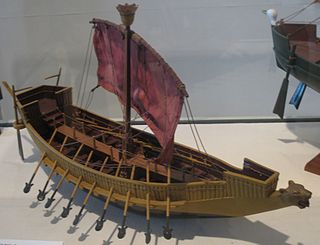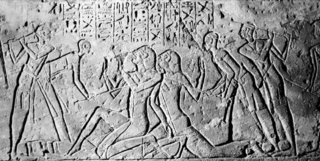 W
WAncient Egypt was an ancient civilization of eastern North Africa, concentrated along the northern reaches of the Nile River in Egypt. The civilization coalesced around 3150 BC with the political unification of Upper and Lower Egypt under the first pharaoh, and it developed over the next three millennia. Its history occurred in a series of stable kingdoms, separated by periods of relative instability known as intermediate periods. Ancient Egypt reached its pinnacle during the New Kingdom, after which it entered a period of slow decline. Egypt was conquered by a succession of foreign powers in the late period, and the rule of the pharaohs officially ended in 31 BC, when the early Roman Empire conquered Egypt and made it a province. Although the Egyptian military forces in the Old and Middle kingdoms were well maintained, the new form that emerged in the New Kingdom showed the state becoming more organized to serve its needs.
 W
WThe ancient Egyptian navy has a very extensive history almost as old as the nation itself. Our best sources over the type of ships they used and their purposes come from the reliefs from the various religious temples that spread throughout the land. While the early ships that were used to sail the Nile were often made out of reeds, the ocean and seagoing ships were then made out of cedar wood, most probably from the woods of Byblos in present day Lebanon. While the use of navy was not as important to the Egyptians as it may have been to the Greeks or Romans, it still proved its worth during the Thutmoside campaigns and even in defending Egypt under Rameses III. Thutmose III understood the importance in maintaining a fast and efficient communications and supply line that would connect his bases in the Levantine region with Egypt. For this reason, he constructed his famous dockyard for the royal fleet near Memphis, whose sole purpose was to constantly supply the campaigning Egyptian army with additional troops as well as communication with Egypt and general supplies.
 W
WIn ancient Egyptian society chariotry stood as an independent unit in the King’s military force. Chariots are thought to have been first used as a weapon in Egypt by the Hyksos in the 16th century BC. The Egyptians then developed their own chariot design.
 W
WThe Kadesh inscriptions or Qadesh inscriptions are a variety of Egyptian hieroglyphic inscriptions describing the Battle of Kadesh. The combined evidence in the form of texts and wall reliefs provide the best documented description of a battle in all of ancient history.
 W
WThe term máchimoi commonly refers to a broad category of ancient Egyptian low-ranked soldiers which rose during the Late Period of Egypt and, more prominently, during the Ptolemaic dynasty.
 W
WNubia is a region along the Nile river encompassing the area between the first cataract of the Nile as well as the confluence of the blue and white Niles or, more strictly, Al Dabbah. Nubia was the seat of several civilizations of ancient Africa, including the Kerma culture, the kingdom of Kush, Nobatia, Makuria and Alodia.
 W
WThe Nine Bows is a visual representation in Ancient Egyptian art of foreigners or others. Besides the nine bows, there were no other generic representations of foreigners. Due to its ability to stand in for any nine enemies to Ancient Egypt, the peoples covered by this term changed over time as enemies changed, and there is no true list of the nine bows.
 W
WThe Sayala Mace or Seyala Mace is a ceremonial mace made of gold plated wood and stone, from Predynastic Egypt. It was found by Cecil Mallaby Firth in 1910–11 at Sayala in Lower Nubia and subsequently kept in the Egyptian Museum in Cairo until it was stolen in 1920. Its later fate is unknown. The mace is especially significant for the detailed depictions of animals on its handle.